Revealing the Spatiotemporal Changes in Land Use and Landscape Patterns and Their Effects on Ecosystem Services: A Case Study in the Western Sichuan Urban Agglomeration, China
Abstract
1. Introduction
2. Materials and Methods
2.1. Study Area
2.2. Theoretical Mechanisms
2.3. Data Sources
2.4. Detecting Spatial and Temporal Changes in Land Use Processes and Landscape Pattern Structures
2.4.1. Detection of Spatiotemporal Changes in Land Use Processes
2.4.2. Analysis of Landscape Pattern Structures
2.5. Ecosystem Services Valuation
2.6. Construction of the Response of ESV to Land Use Processes and Landscape Pattern Structure
2.6.1. Calculations of the Response of ESV to Land Use Processes
2.6.2. Calculations of the Response of ESV to Landscape Pattern Structure
3. Results
3.1. Analysis of Land Use Processes and Landscape Pattern Structures Changes
3.1.1. Characteristics of Spatiotemporal Changes in Land Use Processes
3.1.2. Characteristics of Structural Changes in Landscape Patterns
3.2. Spatial and Temporal Changes in ESV
3.2.1. Temporal Variability Analysis
3.2.2. Spatial Variability Analysis
3.2.3. Sensitivity Analysis of ESV
3.3. The Response of ESV to Changes in Land Use Processes and Landscape Pattern Structures
3.3.1. Impact of Land Use Processes on the ESV
- (1)
- Impact of land use area on the ESV
- (2)
- The effects of land use transitions on the ESV
3.3.2. Response of ESV to Landscape Pattern Structures
- (1)
- Landscape level indices impacts on ESV
- (2)
- Impact of landscape type level indices on ESV
4. Discussion
4.1. Land Use Processes Lead to Structural Changes in Landscape Patterns
4.2. ESV Responds to Changes in Land Use Processes and the Structure of Landscape Patterns
4.3. Suggestions for Optimizing ESV in the WSUA
- (1)
- To ensure the long-term ecological sustainability of the WSUA, it is crucial to accurately designate ecological priority protection zones, optimize green space planning, promote the multifunctional ecological use of farmland, and implement a region-specific ecological compensation mechanism. In regions where ESV is steadily improving, priority ecological protection zones should be designated by the Technical Guidelines for Ecological Red Line Delineation. Core areas where ESV has shown a sustained and substantial increase, such as the Ya’an section of the Dadu River, should be established as permanent conservation zones with stringent development limitations. Meanwhile, areas with steady ESV growth potential, such as the upper Minjiang River reforestation belt, can facilitate the growth of environmentally friendly industries. Furthermore, a coordinated “core ecological protection zone–urban ecological buffer belt” system should be implemented, establishing a 100–300 m-wide buffer around ESV-enhancing areas while strictly regulating development intensity. For arable land bordering protected areas, “ecological conservation-oriented farming” should be adopted. Regions such as Ya’an and Meishan could implement the “wetland farm + ecological picking garden” model to establish a mutually beneficial balance between conservation and development. A “performance-driven” ecological compensation system should be established to support these initiatives. Provincial financial resources should be allocated for ESV improvement, with a tiered compensation structure applied to regions within protected zones that exhibit sustained ESV growth. Compensation standards should align with the Sichuan Provincial Watershed Horizontal Ecological Protection Compensation Incentive Policy Implementation Plan and be adjusted dynamically based on the annual ESV variation rate.
- (2)
- Based on the sensitivity and spatial distribution of ESV, ecological restoration zones should be strategically delineated along urban fringes to create a well-connected ecological network that integrates mountains, rivers, forests, farmlands, lakes, and grasslands. Sensitivity analysis revealed that forestland exhibited the most pronounced response to ESV variations, underscoring its essential regulatory and conservation functions. Therefore, restoring forest ecosystems should be prioritized to preserve both their integrity and connectivity. It is recommended that ecological restoration zones be established in areas experiencing significant ecosystem degradation—such as regions with declining ESV and fragmented forests—particularly along urban fringe areas impacted by expansion. These zones should enhance the stability and connectivity of ecological networks by integrating habitat patches and restoring ecological corridors. Priority should be given to water source protection and wetland restoration projects to rehabilitate aquatic ecosystems and enhance water quality regulation. The development of the Minjiang–Dadu River ecological corridor with wetland restoration and ecological shoreline transformation will promote connectivity within the upper Yangtze River aquatic ecosystems and help regulate regional hydrological processes. A green corridor linking Longquan Mountain and the Tuojiang River should be established based on a mountain–river ecological coupling framework. This initiative will restore natural riparian zones along the Tuojiang River, reconnect fragmented mixed forests in Longquan Mountain, and establish ecological buffer zones in peri-urban areas, forming a continuous landscape-scale ecological network. Furthermore, “forest–grassland” ecological corridors should be created on the urban periphery. For instance, a biodiversity corridor connecting the Longmen and Qionglai Mountains should be delineated with habitat identification, ecological corridor restoration, and disturbance regulation. This would help sustain the genetic exchange of endangered species, such as the giant panda, preserve upstream water sources of the Yangtze River, and mitigate ecological fragmentation caused by urban expansion in the WSUA.
- (3)
- To optimize ecological networks and multifunctional landscape management, it is essential to integrate current land use patterns, economic development levels, and policy directives by implementing a regionally differentiated and category-specific strategy. In the biodiversity core zone of Longmenshan-Qionglai Mountain, natural restoration should be prioritized, with strict development controls. In the core area of the WSUA, existing land resources should be revitalized with urban renewal and the redevelopment of inefficient land use (e.g., old factories and urban villages). The transit-oriented development model should be promoted, prioritizing high-density development around high-speed rail and metro hubs. Adopting the “ecological function zone and permeable green infrastructure” approach in city centers is advisable. For instance, Chengdu’s central district should maintain a green coverage rate of over 20%, with main road green belts measuring no less than 30 m in width. Furthermore, implementing “green roofs and rain gardens” should be encouraged to strengthen ecological connectivity. In the low-mountain ecological forestry zone of Longquanshan, an east–west ecological buffer zone should be established to expand mixed forests, promote suburban recreational green corridors, and limit high-density development, thereby curbing urban sprawl, enhancing ES, and mitigating soil erosion. In the eastern hilly farmland protection area, a “field–forest–pond” integrated ecological network should be developed, the rice-fish farming model should be promoted, and spatial flexibility for urban expansion should be preserved to achieve farmland protection, non-point source pollution mitigation, and urban-rural coordinated development. The “government–market–community” model should be adopted, integrating financial subsidies, ecological compensation, and public–private partnership mechanisms to secure financial sustainability. Public engagement, environmental education, and community co-construction should be promoted to foster public acceptance and advance sustainable development.
4.4. Limitations
5. Conclusions
Author Contributions
Funding
Data Availability Statement
Acknowledgments
Conflicts of Interest
Appendix A. Appendix Tables
| Time | Policy | Measures | Mainly Affects the Type Used | Related Research Results |
|---|---|---|---|---|
| 1998–2020 | Decision of the People’s Government of Sichuan Province on Implementing the Natural Forest Resources Protection Project | Take resolute measures to stop the logging of natural forests, strengthen forest resource management, and promote the construction of ecological public welfare forests. | Forest land | Increase in forest land from 2000 to 2020. |
| 2001 | Implementation Opinions on Several Policy Measures for Western Development | Improve the approval efficiency of construction land, reduce approval procedures, and promptly provide and ensure land for economic development, infrastructure, and industrial parks as the demand for land increases. | Construction land | Explosive increase in construction land. |
| 2002 | Regulations on Returning Farmland to Forests | Farmland with a slope greater than 25 degrees should be converted back to forests or grasslands, with corresponding subsidies provided. | Arable land, forest land, grass land | From 2005 to 2010, the most converted land was arable land, with the majority being transferred to forest land (92,990.43 hm2). |
| 2006—2020 | National Grain Production Development Plan (2006–2020) | Implement the strictest farmland protection system, adopt practical and feasible measures, encourage farmers to plant grain and local governments to focus on grain production, and stabilize the grain sowing area at a reasonable level. | Arable land | After 2005, the rate of decline in arable land slowed down. |
| 2006 | 11th Five-Year Plan for Livestock Development | Strengthen grassland construction and environmental protection and promote the harmonious development of animal husbandry and grassland ecology. | Grass land | After 2005, the rate of decline in grassland slowed down. |
| 2006 | Notice on Strengthening Land Regulation Issues | Clarify the responsibilities for land management and arable land protection and prohibit the unauthorized conversion of agricultural land into construction land. | Arable land | After 2005, the rate of decline in arable land slowed down. |
| 2008 | Special Plan for Ecological Restoration in the Post-Wenchuan Earthquake Recovery and Reconstruction | Protecting natural forests, converting farmland to forests, converting grazing land to grassland, closing mountains for forest restoration, afforestation, and comprehensive watershed management, with ecological restoration projects implemented in the upper reaches of the Min River, Jialing River, Fu River, and Bailong River basins. | Forest land | The restoration of forest land in Mianyang and the northwest of Chengdu aligns with the distribution of high-value and increasing ESV areas. |
| 2009–2020 | Development Plan for the Chengdu Plain Urban Agglomeration | Increase forest coverage and strictly control development in the western mountainous areas. | Forest land, construction land | From 2000 to 2020, the forest area increased, and the high-value ESV areas were primarily distributed in the northern and southwestern mountainous regions. |
| 2011 | Opinions on Accelerating the Interactive Development of New-Type Industrialization and New-Type Urbanization | Coordinate the spatial layout of urban and rural development, make reasonable use of natural resources such as land and water, and protect the natural ecological environment. | Construction land | After 2010, the expansion of construction land slowed down. |
| 2016 | Sichuan’s Water Pollution Control Action Plan | Strictly manage the urban planning blue line and ensure that a certain proportion of water area is retained within the urban planning area. New projects must not unlawfully occupy urban wetlands, rivers, lakes, or other water bodies. | Waters, wetland | From 2000 to 2020, the area of water bodies increased. |
| 2017–2020 | Sichuan Province “13th Five-Year” Ecological Protection and Construction Plan | Focus on protecting forests, grasslands, farmland, wetlands, and river ecosystems. | Forest land, grass land, waters, arable land | From 2015 to 2020, ESV significantly increased. |
| 2018 | Sichuan Province Ecological Protection Red Line Plan | The distribution pattern of ecological protection red lines in Sichuan Province is ‘Four Axes and Nine Cores’. The ‘Four Axes’ refer to the Daba Mountains, the lower reaches of the Jinsha River’s arid river valley, the southeastern Sichuan mountains, and the hilly areas within the basin, which are distributed in a belt-like shape. The ‘Nine Cores’ refer to the Ruoergai Wetland (Yellow River Source), the Yalong River Source, the Dadu River Source, as well as the Daxue Mountain, Shaluo Mountain, Min Mountain, Qionglai Mountain, Liangshan-Xiangling, and Jinping Mountain, which are concentrated and distributed in large areas, with water systems and mountain ranges serving as their framework. | Forest land, grass land, waters, desert | ESV improvement areas are distributed across various cities, mainly in Mianyang, Chengdu, Ya’an, and Leshan. These areas are primarily located in river and lake regions such as the Dadu River, Min River, Fu River, and Sancha Lake, as well as in some agricultural areas along the rivers. They overlap with areas where cropland has been converted into forest, grassland, and water bodies. |
| Landscape Pattern Index | Landscape Level | Formula | Ecological Meaning |
|---|---|---|---|
| PD | Category/Landscape | A is the overall landscape area and N represents the quantity of landscape plates. | The overall patch count in the landscape indicates its heterogeneity and fragmentation. A larger value corresponds to a higher degree of fragmentation. |
| MPS | Category | A is the overall landscape area and N is the number of landscape plates. | The mean area of a specific patch type indicates landscape heterogeneity. |
| ED | Category | E denotes the cumulative length of all patch boundaries within the landscape and A is the overall landscape area. | Reflects the degree of landscape fragmentation: the larger the value, the greater the landscape fragmentation. |
| AI | Category | gii represents the count of neighboring patches of the same landscape type. | Reflects the degree of aggregation of plaques: the larger the value, the more concentrated the plaques. |
| LSI | Landscape | E denotes the cumulative length of all patch boundaries within the landscape and A is the overall landscape area. | Reflects the shape characteristics of patches within the landscape, with larger values indicating more complex types and shapes and more separated patches. |
| SHDI | Landscape | Pi is the area proportion of a landscape patch type i. | Reflecting the diversity and richness of landscape types, a decrease implies that particular landscape types are beginning to dominate or increase their coverage in the landscape. |
| DIVISION | Landscape | TA is the total area of the region; aj is the area of the jth patch of a given landscape type. | It indicates the extent of landscape fragmentation: the closer to 1, the more fragmented the landscape is. |
| CONTAG | Landscape | Pij signifies the likelihood that two randomly chosen neighboring patches are of types i and j. Here, m denotes the total number of patch types. | It reflects the extent of aggregation among patch types, with larger values indicating that the landscape consists of a few clustered large patches with better connectivity. |
| Category I | Category II | Arable Land | Forest Land | Grassland | Weltland | Desert | Waters | Construction Land |
|---|---|---|---|---|---|---|---|---|
| Supply service (SS_supply) | FP | 2103.22 | 767.06 | 940.27 | 1261.93 | 0.00 | 1979.51 | 0 |
| RMP | 989.75 | 1756.81 | 1385.65 | 1237.19 | 0.00 | 569.11 | 0 | |
| WS | 40.60 | 751.10 | 629.30 | 5257.73 | 0.00 | 16,828.81 | 0 | |
| Regulatory services (RS) | GR | 1657.84 | 5814.80 | 4874.53 | 4701.33 | 49.49 | 1905.27 | 0 |
| CR | 890.78 | 17,394.90 | 12,891.53 | 8907.77 | 0.00 | 5666.33 | 0 | |
| DTE | 247.44 | 4924.02 | 4255.94 | 8907.77 | 247.44 | 13,732.82 | 0 | |
| HR | 548.10 | 7125.35 | 7754.65 | 49,187.22 | 60.90 | 207,548.57 | 0 | |
| Support Services (SS_support) | SC | 2090.91 | 5805.84 | 4872.03 | 4689.33 | 40.60 | 1887.91 | 0 |
| MNC | 296.93 | 544.36 | 445.39 | 445.39 | 0.00 | 173.21 | 0 | |
| BD | 321.67 | 6433.39 | 5394.15 | 19,473.38 | 49.49 | 6309.67 | 0 | |
| Cultural service (CS) | AL | 148.46 | 2820.80 | 2375.41 | 11,703.83 | 24.74 | 4676.58 | 0 |
| Ecosystem Services | ESV/(108 RMB) | 2000–2020 ESV (108 RMB) | Rate of Change/% | |||||
|---|---|---|---|---|---|---|---|---|
| Category I | Category II | 2000 | 2005 | 2010 | 2015 | 2020 | ||
| SS_supply | FP | 127.66 | 126.54 | 125.49 | 124.62 | 123.78 | −3.88 | −3.04% |
| RMP | 108.50 | 108.12 | 107.47 | 106.96 | 106.48 | −2.02 | −1.86% | |
| WS | 44.52 | 44.59 | 45.74 | 46.96 | 47.80 | 3.27 | 7.35% | |
| RS | GR | 289.61 | 289.28 | 287.64 | 286.69 | 285.81 | −3.79 | −1.31% |
| CR | 664.36 | 665.65 | 663.56 | 662.72 | 661.91 | −2.45 | −0.37% | |
| DTE | 205.89 | 206.29 | 206.23 | 206.85 | 207.23 | 1.34 | 0.65% | |
| HR | 488.76 | 489.41 | 503.34 | 518.84 | 529.36 | 40.61 | 8.31% | |
| SS_support | SC | 308.78 | 308.20 | 306.38 | 305.23 | 304.16 | −4.62 | −1.50% |
| MNC | 33.36 | 33.25 | 33.04 | 32.89 | 32.74 | −0.62 | −1.86% | |
| BD | 259.02 | 259.54 | 258.28 | 257.94 | 257.72 | −1.30 | −0.50% | |
| CS | AL | 116.29 | 116.52 | 116.02 | 115.96 | 115.94 | −0.36 | −0.31% |
| Land Space | FP | RMP | WS | GR | CR | DTE | HR | SC | MNC | BD | AL |
|---|---|---|---|---|---|---|---|---|---|---|---|
| Arable land | 0.999 ** | 0.993 ** | −0.962 ** | 0.977 ** | 0.825 | −0.955 * | −0.960 ** | 0.984 ** | 0.992 ** | 0.849 | 0.767 |
| Forest land | −0.851 | −0.841 | 0.782 | −0.856 | −0.743 | 0.636 | 0.775 | −0.854 | −0.846 | −0.846 | −0.858 |
| Grassland | 0.877 | 0.891 * | −0.872 | 0.920 * | 0.883 * | −0.698 | −0.867 | 0.912 * | 0.896 * | 0.951 * | 0.957 * |
| Weltland | 0.959 ** | 0.980 ** | −0.990 ** | 0.993 ** | 0.948 * | −0.899 * | −0.989 ** | 0.989 ** | 0.981 ** | 0.964 ** | 0.913 * |
| Desert | −0.873 | −0.880 * | 0.851 | −0.906 * | −0.851 | 0.681 | 0.845 | −0.900 * | −0.886 * | −0.929 * | −0.937 * |
| Waters | −0.961 ** | −0.984 ** | 1.000 ** | −0.991 ** | −0.945 * | 0.934 * | 0.999 ** | −0.989 ** | −0.984 ** | −0.943 * | −0.875 |
| Period | Positive ESV Effects | Negative ESV Effects | ||||
|---|---|---|---|---|---|---|
| Land Use Transfers | ESV Contribution | Percentage | Land Use Transfers | ESV Contribution | Percentage | |
| 2000 –2020 | Grassland–Forest land | 125.87 | 4.54% | Grassland–Arable land | 253.47 | 10.28% |
| Grassland–Weltland | 0.92 | 0.03% | Grassland–Desert | 10.36 | 0.42% | |
| Grassland–Waters | 63.04 | 2.28% | Grassland–Construction land | 23.38 | 0.95% | |
| Arable land–Grassland | 205.75 | 7.43% | Arable land–Desert | 0.97 | 0.04% | |
| Arable land–Forest land | 1169.99 | 42.24% | Arable land–Construction land | 235.14 | 9.54% | |
| Arable land–Weltland | 24.40 | 0.88% | Desert–Construction land | 0.00 | 0.00% | |
| Arable land–Waters | 774.71 | 27.97% | Forest land–Grassland | 91.25 | 3.70% | |
| Desert–Grassland | 5.36 | 0.19% | Forest land–Arable land | 1110.94 | 45.06% | |
| Desert–Arable land | 0.17 | 0.01% | Forest land–Desert | 60.78 | 2.47% | |
| Desert–Forest land | 5.58 | 0.20% | Forest land–Construction land | 45.22 | 1.83% | |
| Desert–Weltland | 0.43 | 0.02% | Weltland–Grassland | 0.35 | 0.01% | |
| Desert–Waters | 14.53 | 0.52% | Weltland–Arable land | 33.60 | 1.36% | |
| Construction land–Grassland | 10.87 | 0.39% | Weltland–Desert | 0.12 | 0.00% | |
| Construction land–Arable land | 44.59 | 1.61% | Weltland–Construction land | 11.44 | 0.46% | |
| Construction land–Desert | 0.00 | 0.00% | Weltland–Forest land | 1.14 | 0.05% | |
| Construction land–Forest land | 20.23 | 0.73% | Waters–Grassland | 11.44 | 0.46% | |
| Construction land–Weltland | 2.20 | 0.08% | Waters–Arable land | 408.81 | 16.58% | |
| Construction land–Waters | 67.71 | 2.44% | Waters–Desert | 6.74 | 0.27% | |
| Forest land–Weltland | 1.95 | 0.07% | Waters–Construction land | 101.65 | 4.12% | |
| Forest land–Waters | 124.89 | 4.51% | Waters–Forest land | 38.31 | 1.55% | |
| Weltland–Waters | 106.50 | 3.85% | Waters–Weltland | 20.54 | 0.83% | |
| Total value | 2769.70 | 100.00% | total value | 2465.66 | 100.00% | |
Appendix B. Appendix Figures



References
- Costanza, R.; Hannon, B.; Limburg, K.; Naeem, S.; O’Neill, R.V.; Raskin, R.G.; Sutton, P. The Value of the World’s Ecosystem Services and Natural Capital. Nature 1997, 387, 253–260. [Google Scholar] [CrossRef]
- Balvanera, P.; Quijas, S.; Karp, D.S.; Ash, N.; Bennett, E.M.; Boumans, R.; Brown, C.; Chan, K.M.A.; Chaplin-Kramer, R.; Halpern, B.S.; et al. Ecosystem Services. In The GEO Handbook on Biodiversity Observation Networks; Walters, M., Scholes, R.J., Eds.; Springer International Publishing: Cham, Switzerland, 2017; pp. 39–78. ISBN 978-3-319-27288-7. [Google Scholar]
- Yu, B. Ecological Effects of New-Type Urbanization in China. Renew. Sustain. Energy Rev. 2021, 135, 110239. [Google Scholar] [CrossRef]
- Zang, S.; Wu, C.; Liu, H.; Na, X. Impact of Urbanization on Natural Ecosystem Service Values: A Comparative Study. Environ. Monit. Assess. 2011, 179, 575–588. [Google Scholar] [CrossRef] [PubMed]
- Li, J.; Chen, X.; De Maeyer, P.; Van de Voorde, T.; Li, Y. Ecological Security Warning in Central Asia: Integrating Ecosystem Services Protection under SSPs-RCPs Scenarios. Sci. Total Environ. 2024, 912, 168698. [Google Scholar] [CrossRef] [PubMed]
- Yu, C.; Zhang, Z.; Jeppesen, E.; Gao, Y.; Liu, Y.; Liu, Y.; Lu, Q.; Wang, C.; Sun, X. Assessment of the Effectiveness of China’s Protected Areas in Enhancing Ecosystem Services. Ecosyst. Serv. 2024, 65, 101588. [Google Scholar] [CrossRef]
- Hasan, S.S.; Zhen, L.; Miah, M.G.; Ahamed, T.; Samie, A. Impact of Land Use Change on Ecosystem Services: A Review. Environ. Dev. 2020, 34, 100527. [Google Scholar] [CrossRef]
- Mohammadyari, F.; Tavakoli, M.; Zarandian, A.; Abdollahi, S. Optimization Land Use Based on Multi-Scenario Simulation of Ecosystem Service for Sustainable Landscape Planning in a Mixed Urban—Forest Watershed. Ecol. Model. 2023, 483, 110440. [Google Scholar] [CrossRef]
- Luo, Y.; Guo, X.; Lü, Y.; Zhang, L.; Li, T. Combining Spatiotemporal Interactions of Ecosystem Services with Land Patterns and Processes Can Benefit Sensible Landscape Management in Dryland Regions. Sci. Total Environ. 2024, 909, 168485. [Google Scholar] [CrossRef] [PubMed]
- Gomes, E.; Inácio, M.; Bogdzevič, K.; Kalinauskas, M.; Karnauskaitė, D.; Pereira, P. Future Land-Use Changes and Its Impacts on Terrestrial Ecosystem Services: A Review. Sci. Total Environ. 2021, 781, 146716. [Google Scholar] [CrossRef]
- Kong, X.; Fu, M.; Zhao, X.; Wang, J.; Jiang, P. Ecological Effects of Land-Use Change on Two Sides of the Hu Huanyong Line in China. Land Use Policy 2022, 113, 105895. [Google Scholar] [CrossRef]
- Fang, L.; Wang, L.; Chen, W.; Sun, J.; Cao, Q.; Wang, S.; Wang, L. Identifying the Impacts of Natural and Human Factors on Ecosystem Service in the Yangtze and Yellow River Basins. J. Clean. Prod. 2021, 314, 127995. [Google Scholar] [CrossRef]
- Yang, Y.; Qin, T.; Yan, D.; Liu, S.; Feng, J.; Wang, Q.; Liu, H.; Gao, H. Analysis of the Evolution of Ecosystem Service Value and Its Driving Factors in the Yellow River Source Area, China. Ecol. Indic. 2024, 158, 111344. [Google Scholar] [CrossRef]
- Adelisardou, F.; Jafari, H.R.; Malekmohammadi, B.; Minkina, T.; Zhao, W.; Karbassi, A. Impacts of Land Use and Land Cover Change on the Interactions among Multiple Soil-Dependent Ecosystem Services (Case Study: Jiroft Plain, Iran). Environ. Geochem. Health 2021, 43, 3977–3996. [Google Scholar] [CrossRef] [PubMed]
- Pereira, P.; Inacio, M.; Kalinauskas, M.; Bogdzevič, K.; Bogunovic, I.; Zhao, W. Chapter 1—Land-Use Changes and Ecosystem Services. In Mapping and Forecasting Land Use; Pereira, P., Gomes, E., Rocha, J., Eds.; Elsevier: Amsterdam, The Netherlands, 2022; pp. 1–27. ISBN 978-0-323-90947-1. [Google Scholar]
- Hysa, A.; Löwe, R.; Geist, J. Ecosystem Services Potential Is Declining across European Capital Metropolitan Areas. Sci. Rep. 2024, 14, 8903. [Google Scholar] [CrossRef] [PubMed]
- Zheng, H.; Peng, J.; Qiu, S.; Xu, Z.; Zhou, F.; Xia, P.; Adalibieke, W. Distinguishing the Impacts of Land Use Change in Intensity and Type on Ecosystem Services Trade-Offs. J. Environ. Manag. 2022, 316, 115206. [Google Scholar] [CrossRef] [PubMed]
- Fu, B.; Zhang, L.; Xu, Z.; Zhao, Y.; Wei, Y.; Skinner, D. Ecosystem Services in Changing Land Use. J. Soils Sediments 2015, 15, 833–843. [Google Scholar] [CrossRef]
- Duan, X.; Chen, Y.; Wang, L.; Zheng, G.; Liang, T. The Impact of Land Use and Land Cover Changes on the Landscape Pattern and Ecosystem Service Value in Sanjiangyuan Region of the Qinghai-Tibet Plateau. J. Environ. Manag. 2023, 325, 116539. [Google Scholar] [CrossRef] [PubMed]
- Schirpke, U.; Tscholl, S.; Tasser, E. Spatio-Temporal Changes in Ecosystem Service Values: Effects of Land-Use Changes from Past to Future (1860–2100). J. Environ. Manag. 2020, 272, 111068. [Google Scholar] [CrossRef]
- Han, L.; Li, Y.; Ge, Z.; Fang, F.; Gao, L.; Zhang, J.; Du, Z.; Cui, L. Study on the Spatial and Temporal Evolution of Ecosystem Service Value Based on Land Use Change in Xi’an City. Sci. Rep. 2025, 15, 66. [Google Scholar] [CrossRef] [PubMed]
- Zhong, M. Impact of Landscape Patterns on Ecosystem Services in China: A Case Study of the Central Plains Urban Agglomeration. Front. Environ. Sci. 2024, 12, 1285679. [Google Scholar] [CrossRef]
- Zhang, M.; Chen, E.; Zhang, C.; Liu, C.; Li, J. Multi-Scenario Simulation of Land Use Change and Ecosystem Service Value Based on the Markov–FLUS Model in Ezhou City, China. Sustainability 2024, 16, 6237. [Google Scholar] [CrossRef]
- Turner, M.G.; Gardner, R.H. (Eds.) Landscape Disturbance Dynamics. In Landscape Ecology in Theory and Practice: Pattern and Process; Springer: New York, NY, USA, 2015; pp. 175–228. ISBN 978-1-4939-2794-4. [Google Scholar]
- Millennium Ecosystem Assessment. Millennium Ecosystem Assessment; Millennium Ecosystem Assessment: Washington, DC, USA, 2001; Volume 2. [Google Scholar]
- Chan, K.M.A.; Satterfield, T. The Maturation of Ecosystem Services: Social and Policy Research Expands, but Whither Biophysically Informed Valuation? People Nat. 2020, 2, 1021–1060. [Google Scholar] [CrossRef]
- Xiao, J.; Zhang, Y.; Xu, H. Response of Ecosystem Service Values to Land Use Change, 2002–2021. Ecol. Indic. 2024, 160, 111947. [Google Scholar] [CrossRef]
- Duan, L.; Yang, S.; Xiang, M.; Li, W.; Li, J. Spatiotemporal Evolution and Driving Factors of Ecosystem Service Value in the Upper Minjiang River of China. Sci. Rep. 2024, 14, 23398. [Google Scholar] [CrossRef] [PubMed]
- Ratanakuakangwan, S.; Morita, H. An Efficient Energy Planning Model Optimizing Cost, Emission, and Social Impact with Different Carbon Tax Scenarios. Appl. Energy 2022, 325, 119792. [Google Scholar] [CrossRef]
- Häyhä, T.; Franzese, P.P. Ecosystem Services Assessment: A Review under an Ecological-Economic and Systems Perspective. Ecol. Model. 2014, 289, 124–132. [Google Scholar] [CrossRef]
- Zhang, B.; Li, W.; Xie, G. Ecosystem Services Research in China: Progress and Perspective. Ecol. Econ. 2010, 69, 1389–1395. [Google Scholar] [CrossRef]
- Chen, H. Land Use Trade-Offs Associated with Protected Areas in China: Current State, Existing Evaluation Methods, and Future Application of Ecosystem Service Valuation. Sci. Total Environ. 2020, 711, 134688. [Google Scholar] [CrossRef]
- Meraj, G.; Singh, S.K.; Kanga, S.; Islam, M.N. Modeling on Comparison of Ecosystem Services Concepts, Tools, Methods and Their Ecological-Economic Implications: A Review. Model. Earth Syst. Environ. 2022, 8, 15–34. [Google Scholar] [CrossRef]
- Ouyang, Z.Y.; Wang, X.K.; Miao, H. A primary study On Chinese terrestrial ecosystem services and their ecological-economic values. Acta Ecol. Sin. 1999, 19, 607–613. [Google Scholar]
- Xie, G.D.; Zhen, L.; Lu, C.X.; Xiao, Y.; Chen, C. An expert knowledge-based approach to the valorization of ecosystem services. J. Nat. Resour. 2008, 23, 911–919. [Google Scholar]
- Pan, N.; Guan, Q.; Wang, Q.; Sun, Y.; Li, H.; Ma, Y. Spatial Differentiation and Driving Mechanisms in Ecosystem Service Value of Arid Region: A Case Study in the Middle and Lower Reaches of Shule River Basin, NW China. J. Clean. Prod. 2021, 319, 128718. [Google Scholar] [CrossRef]
- Kusi, K.K.; Khattabi, A.; Mhammdi, N. Analyzing the Impact of Land Use Change on Ecosystem Service Value in the Main Watersheds of Morocco. Environ. Dev. Sustain. 2023, 25, 2688–2715. [Google Scholar] [CrossRef]
- Mendoza-González, G.; Martínez, M.L.; Lithgow, D.; Pérez-Maqueo, O.; Simonin, P. Land Use Change and Its Effects on the Value of Ecosystem Services along the Coast of the Gulf of Mexico. Ecol. Econ. 2012, 82, 23–32. [Google Scholar] [CrossRef]
- Roy, S.K.; Alam, M.T.; Mojumder, P.; Mondal, I.; Kafy, A.-A.; Dutta, M.; Ferdous, M.N.; Al Mamun, M.A.; Mahtab, S.B. Dynamic Assessment and Prediction of Land Use Alterations Influence on Ecosystem Service Value: A Pathway to Environmental Sustainability. Environ. Sustain. Indic. 2024, 21, 100319. [Google Scholar] [CrossRef]
- Ersoy Tonyaloğlu, E. Future Land Use/Land Cover and Its Impacts on Ecosystem Services: Case of Aydın, Turkey. Int. J. Environ. Sci. Technol. 2025, 22, 4601–4617. [Google Scholar] [CrossRef]
- Ocloo, M.D.; Huang, X.; Fan, M.; Ou, W. Study on the Spatial Changes in Land Use and Landscape Patterns and Their Effects on Ecosystem Services in Ghana, West Africa. Environ. Dev. 2024, 49, 100947. [Google Scholar] [CrossRef]
- Zhang, J.; Qu, M.; Wang, C.; Zhao, J.; Cao, Y. Quantifying Landscape Pattern and Ecosystem Service Value Changes: A Case Study at the County Level in the Chinese Loess Plateau. Glob. Ecol. Conserv. 2020, 23, e01110. [Google Scholar] [CrossRef]
- Hou, L.; Liu, T.; Wang, J.; Chen, X.; Du, Z.; Xu, S.; Yu, L. Land Disturbance Tempo-Spatial Dynamics in Mountainous Urban Agglomeration and Its Driving Forces: A Case Study of West Sichuan Urban Agglomeration, China. Ecol. Indic. 2023, 154, 110569. [Google Scholar] [CrossRef]
- Haines-Young, R.; Potschin, M. The Links between Biodiversity, Ecosystem Services and Human Well-Being. In Ecosystem Ecology: A New Synthesis; Frid, C.L.J., Raffaelli, D.G., Eds.; Ecological Reviews; Cambridge University Press: Cambridge, UK, 2010; pp. 110–139. ISBN 978-0-521-51349-4. [Google Scholar]
- Fu, B.; Liu, Y.; Zhao, W.; Wu, J. The Emerging “Pattern-Process-Service-Sustainability” Paradigm in Landscape Ecology. Landsc. Ecol. 2025, 40, 54. [Google Scholar] [CrossRef]
- Fu, B.; Wu, X.; Wang, Z.; Wu, X.; Wang, S. Coupling Human and Natural Systems for Sustainability: Experience from China’s Loess Plateau. Earth Syst. Dyn. 2022, 13, 795–808. [Google Scholar] [CrossRef]
- Liang, X.; Jin, X.; Ren, J.; Gu, Z.; Zhou, Y. A Research Framework of Land Use Transition in Suzhou City Coupled with Land Use Structure and Landscape Multifunctionality. Sci. Total Environ. 2020, 737, 139932. [Google Scholar] [CrossRef] [PubMed]
- Costanza, R.; de Groot, R.; Braat, L.; Kubiszewski, I.; Fioramonti, L.; Sutton, P.; Farber, S.; Grasso, M. Twenty Years of Ecosystem Services: How Far Have We Come and How Far Do We Still Need to Go? Ecosyst. Serv. 2017, 28, 1–16. [Google Scholar] [CrossRef]
- Howarth, R.B.; Farber, S. Accounting for the Value of Ecosystem Services. Ecol. Econ. 2002, 41, 421–429. [Google Scholar] [CrossRef]
- Liu, T.; Yu, L.; Liu, J.; Xu, Z.; Chen, X.; Wu, H.; Zheng, S.; Zhao, Q.; Gong, P. Unveiling Interprovincial Geographic Patterns of 5A-Level Tourism Cultural Ecosystem Service Flows and Tourist Preferences in China’s Metacoupled Systems. Appl. Geogr. 2024, 172, 103432. [Google Scholar] [CrossRef]
- Fu, B.; Tian, T.; Liu, Y.; Zhao, W. New Developments and Perspectives in Physical Geography in China. Chin. Geogr. Sci. 2019, 29, 363–371. [Google Scholar] [CrossRef]
- Wenhui, K.; Shuwen, Z.; Guoming, D.U.; Changzhen, Y.a.N.; Shixin, W.U.; Rendong, L.I.; Dengsheng, L.U.; Tao, P.a.N.; Jing, N.; Changqing, G.U.O.; et al. Remotely Sensed Mapping and Analysis of Spatio-Temporal Patterns of Land Use Change across China in 2015–2020. Acta Geogr. Sin. 2022, 77, 1056–1071. [Google Scholar] [CrossRef]
- Liu, J.; Kuang, W.; Zhang, Z.; Xu, X.; Qin, Y.; Ning, J.; Zhou, W.; Zhang, S.; Li, R.; Yan, C.; et al. Spatiotemporal Characteristics, Patterns, and Causes of Land-Use Changes in China since the Late 1980s. J. Geogr. Sci. 2014, 24, 195–210. [Google Scholar] [CrossRef]
- Yang, F.; Yang, X.; Wang, Z.; Sun, Y.; Zhang, Y.; Xing, H.; Wang, Q. Spatiotemporal Evolution of Production–Living–Ecological Land and Its Eco-Environmental Response in China’s Coastal Zone. Remote Sens. 2023, 15, 3039. [Google Scholar] [CrossRef]
- Huang, W.; Shrestha, A.; Xie, Y.; Yan, J.; Wang, J.; Guo, F.; Cao, Y.; Wang, G. Assessing Four Decades of Land Use and Land Cover Change: Policy Impacts and Environmental Dynamics in the Min River Basin, Fujian, China. Land 2025, 14, 11. [Google Scholar] [CrossRef]
- Xu, J.; Renaud, F.G.; Barrett, B. Modelling Land System Evolution and Dynamics of Terrestrial Carbon Stocks in the Luanhe River Basin, China: A Scenario Analysis of Trade-Offs and Synergies between Sustainable Development Goals. Sustain. Sci. 2022, 17, 1323–1345. [Google Scholar] [CrossRef] [PubMed]
- Wang, W.; Wang, X.; Wang, L.; Zhang, Z.; Lyu, D. Spatio-Temporal Variation and Drivers of Land-Use Net Carbon Emissions in Chengyu Urban Agglomeration, China. Land 2024, 13, 2160. [Google Scholar] [CrossRef]
- Xie, G.D.; Zhang, C.X.; Zhang, L.M.; Chen, W.H.; Li, S.M. lmprovement of the Evaluation Method for Ecosystem Service Value Based on Per Unit Area. J. Nat. Resour. 2015, 30, 1243–1254. [Google Scholar]
- Wang, X.L.; Bao, Y.H. Exploration of research methods on dynamic land use change. Prog. Geogr. 1999, 18, 81–87. [Google Scholar] [CrossRef]
- Zhang, X.; Wan, W.; Fan, H.; Dong, X.; Lv, T. Temporal and Spatial Responses of Landscape Patterns to Habitat Quality Changes in the Poyang Lake Region, China. J. Nat. Conserv. 2024, 77, 126546. [Google Scholar] [CrossRef]
- Li, H.; Wu, J. Use and Misuse of Landscape Indices. Landsc. Ecol. 2004, 19, 389–399. [Google Scholar] [CrossRef]
- LIETH, H. Evapotranspiration and Primary Productivity; C. W. THORNTHWAITE Memorial Model. Publ. Climatol. 1972, 25, 37–46. [Google Scholar]
- Su, K.; Wei, D.; Lin, W. Evaluation of Ecosystem Services Value and Its Implications for Policy Making in China—A Case Study of Fujian Province. Ecol. Indic. 2020, 108, 105752. [Google Scholar] [CrossRef]
- He, Y.; Wang, W.; Chen, Y.; Yan, H. Assessing Spatio-Temporal Patterns and Driving Force of Ecosystem Service Value in the Main Urban Area of Guangzhou. Sci. Rep. 2021, 11, 3027. [Google Scholar] [CrossRef] [PubMed]
- Zhu, L.; Zhu, K.; Zeng, X. Evolution of Landscape Pattern and Response of Ecosystem Service Value in International Wetland Cities: A Case Study of Nanchang City. Ecol. Indic. 2023, 155, 110987. [Google Scholar] [CrossRef]
- Shi, F.; Zhou, B.; Zhou, H.; Zhang, H.; Li, H.; Li, R.; Guo, Z.; Gao, X. Spatial Autocorrelation Analysis of Land Use and Ecosystem Service Value in the Huangshui River Basin at the Grid Scale. Plants 2022, 11, 2294. [Google Scholar] [CrossRef] [PubMed]
- Bai, Y.; Xu, H.; Ling, H. Eco-Service Value Evaluation Based on Eco-Economic Functional Regionalization in a Typical Basin of Northwest Arid Area, China. Environ. Earth Sci. 2014, 71, 3715–3726. [Google Scholar] [CrossRef]
- Yohannes, H.; Soromessa, T.; Argaw, M.; Dewan, A. Impact of Landscape Pattern Changes on Hydrological Ecosystem Services in the Beressa Watershed of the Blue Nile Basin in Ethiopia. Sci. Total Environ. 2021, 793, 148559. [Google Scholar] [CrossRef] [PubMed]
- Zhang, J.; Xiang, H.; Hashimoto, S.; Okuro, T. Observational Scale Matters for Ecosystem Services Interactions and Spatial Distributions: A Case Study of the Ussuri Watershed, China. Sustainability 2021, 13, 10649. [Google Scholar] [CrossRef]
- Deng, J.S.; Wang, K.; Hong, Y.; Qi, J.G. Spatio-Temporal Dynamics and Evolution of Land Use Change and Landscape Pattern in Response to Rapid Urbanization. Landsc. Urban Plan. 2009, 92, 187–198. [Google Scholar] [CrossRef]
- Serra, P.; Pons, X.; Saurí, D. Land-Cover and Land-Use Change in a Mediterranean Landscape: A Spatial Analysis of Driving Forces Integrating Biophysical and Human Factors. Appl. Geogr. 2008, 28, 189–209. [Google Scholar] [CrossRef]
- Zhou, Y.; Li, X.; Liu, Y. Land Use Change and Driving Factors in Rural China during the Period 1995–2015. Land Use Policy 2020, 99, 105048. [Google Scholar] [CrossRef]
- Kuang, W. National Urban Land-Use/Cover Change since the Beginning of the 21st Century and Its Policy Implications in China. Land Use Policy 2020, 97, 104747. [Google Scholar] [CrossRef]
- Duveiller, G.; Caporaso, L.; Abad-Viñas, R.; Perugini, L.; Grassi, G.; Arneth, A.; Cescatti, A. Local Biophysical Effects of Land Use and Land Cover Change: Towards an Assessment Tool for Policy Makers. Land Use Policy 2020, 91, 104382. [Google Scholar] [CrossRef]
- Ma, F.; Cai, Y.L. Impacts on the Land Use and Ecosystem Services Value in Shanghai Lingang New City Exploitation. J. Fudan Univ. Sci. 2013, 52, 69–77. [Google Scholar] [CrossRef]
- Yang, W.Q.; Yang, P.; Sun, X.; Han, B.L. Changes of landscape pattern and its impacts on multiple ecosystem services in Beijing. Acta Ecol. Sin. 2022, 42, 6487–6498. [Google Scholar]
- Wang, W.; Feng, C.; Liu, F.; Li, J. Biodiversity Conservation in China: A Review of Recent Studies and Practices. Environ. Sci. Ecotechnol. 2020, 2, 100025. [Google Scholar] [CrossRef] [PubMed]
- Xie, Z. China’s Historical Evolution of Environmental Protection along with the Forty Years’ Reform and Opening-Up. Environ. Sci. Ecotechnol. 2020, 1, 100001. [Google Scholar] [CrossRef]
- Yurui, L.; Xuanchang, Z.; Zhi, C.; Zhengjia, L.; Zhi, L.; Yansui, L. Towards the Progress of Ecological Restoration and Economic Development in China’s Loess Plateau and Strategy for More Sustainable Development. Sci. Total Environ. 2021, 756, 143676. [Google Scholar] [CrossRef] [PubMed]
- Xu, K.; Wang, J.; Wang, J.; Wang, X.; Chi, Y.; Zhang, X. Environmental Function Zoning for Spatially Differentiated Environmental Policies in China. J. Environ. Manag. 2020, 255, 109485. [Google Scholar] [CrossRef] [PubMed]
- Zhang, S.; Zhang, W.; Xu, J.; Zhang, Y. Does the Differentiation of China’s Land Policy Promote Regional Economic Development? Sustainability 2023, 15, 8737. [Google Scholar] [CrossRef]
- Guo, X.; Zhang, Y.; Guo, D.; Lu, W.; Xu, H. How Does Ecological Protection Redline Policy Affect Regional Land Use and Ecosystem Services? Environ. Impact Assess. Rev. 2023, 100, 107062. [Google Scholar] [CrossRef]
- Yu, H.; Chen, C.; Shao, C. Spatial and Temporal Changes in Ecosystem Service Driven by Ecological Compensation in the Xin’an River Basin, China. Ecol. Indic. 2023, 146, 109798. [Google Scholar] [CrossRef]
- Cao, Y.; Kong, L.; Zhang, L.; Ouyang, Z. The Balance between Economic Development and Ecosystem Service Value in the Process of Land Urbanization: A Case Study of China’s Land Urbanization from 2000 to 2015. Land Use Policy 2021, 108, 105536. [Google Scholar] [CrossRef]
- Liu, Y.; Yuan, X.; Li, J.; Qian, K.; Yan, W.; Yang, X.; Ma, X. Trade-Offs and Synergistic Relationships of Ecosystem Services under Land Use Change in Xinjiang from 1990 to 2020: A Bayesian Network Analysis. Sci. Total Environ. 2023, 858, 160015. [Google Scholar] [CrossRef] [PubMed]
- Liu, Y.; Wang, S.; Chen, Z.; Tu, S. Research on the Response of Ecosystem Service Function to Landscape Pattern Changes Caused by Land Use Transition: A Case Study of the Guangxi Zhuang Autonomous Region, China. Land 2022, 11, 752. [Google Scholar] [CrossRef]
- Zhao, J.; Liu, S.; Wang, Z.; Gao, H.; Feng, S.; Wei, B.; Hou, Z.; Xiao, F.; Jing, L.; Liao, X. The Impact of Land Use and Landscape Pattern on Ecosystem Services in the Dongting Lake Region, China. Remote Sens. 2023, 15, 2228. [Google Scholar] [CrossRef]
- Gilman, J.; Wu, J. The Interactions among Landscape Pattern, Climate Change, and Ecosystem Services: Progress and Prospects. Reg. Environ. Change 2023, 23, 67. [Google Scholar] [CrossRef]
- Biswas, G.; Sengupta, A.; Alfaisal, F.M.; Alam, S.; Alharbi, R.S.; Jeon, B.-H. Evaluating the Effects of Landscape Fragmentation on Ecosystem Services: A Three-Decade Perspective. Ecol. Inform. 2023, 77, 102283. [Google Scholar] [CrossRef]
- Hou, L.; Wu, F.; Xie, X. The Spatial Characteristics and Relationships between Landscape Pattern and Ecosystem Service Value along an Urban-Rural Gradient in Xi’an City, China. Ecol. Indic. 2020, 108, 105720. [Google Scholar] [CrossRef]
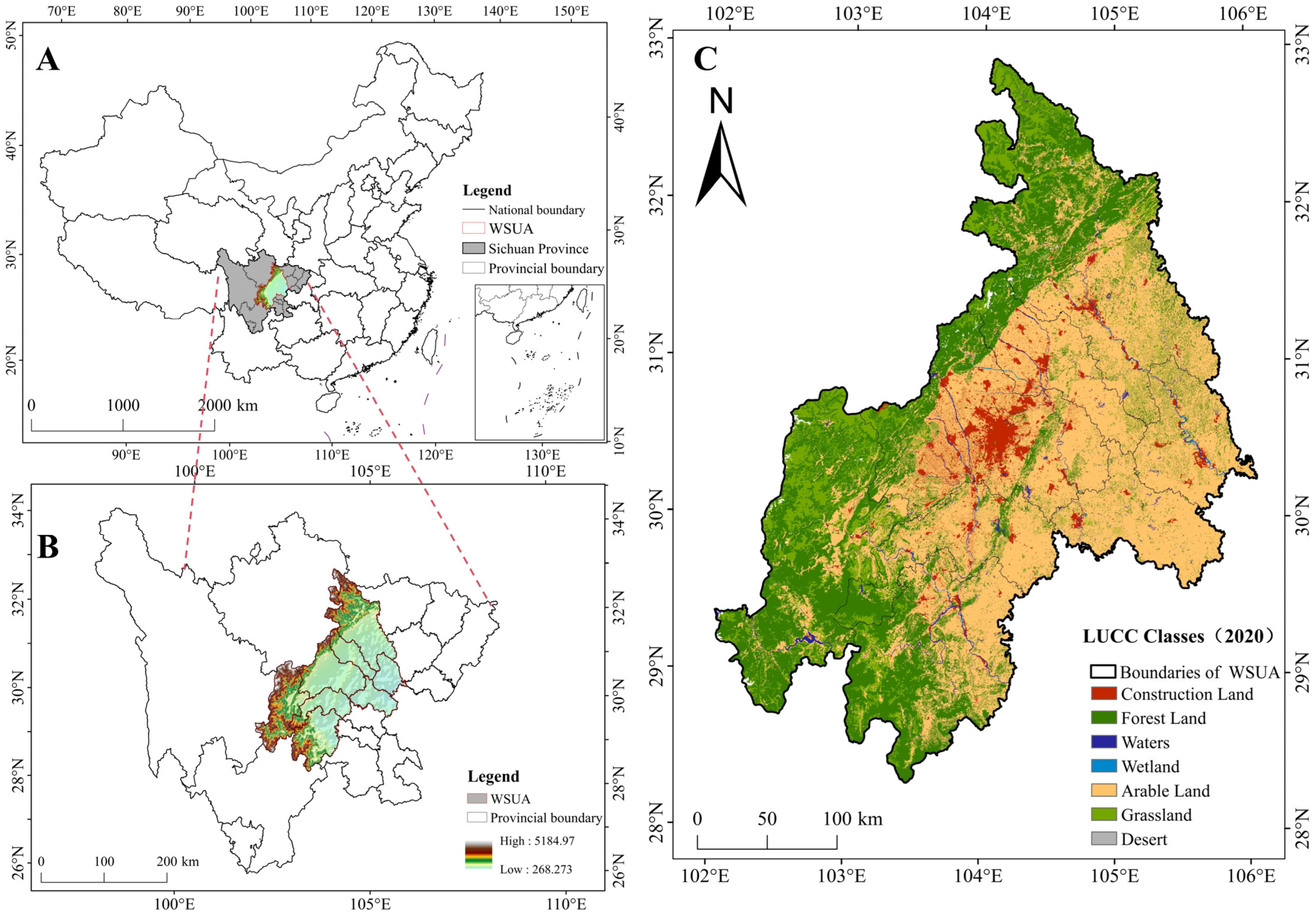
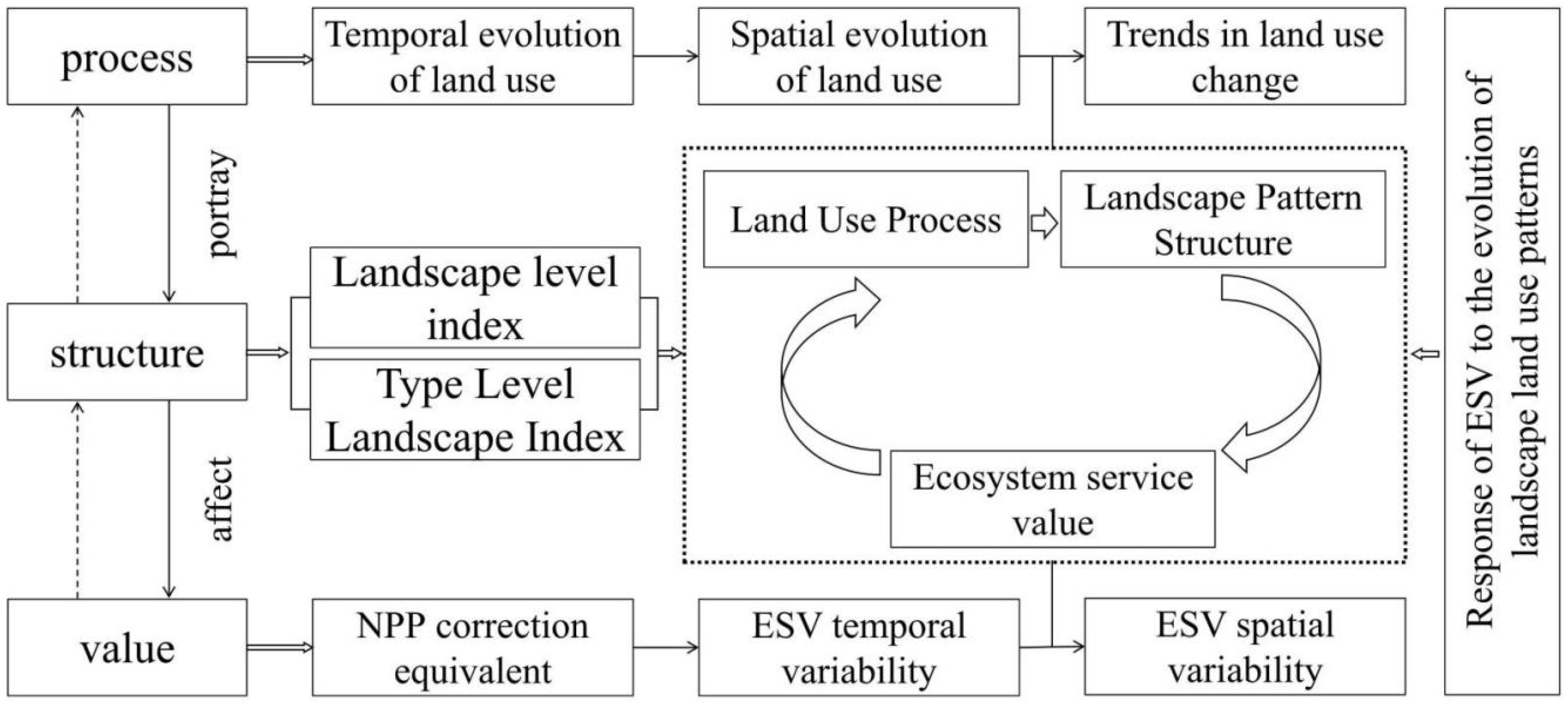
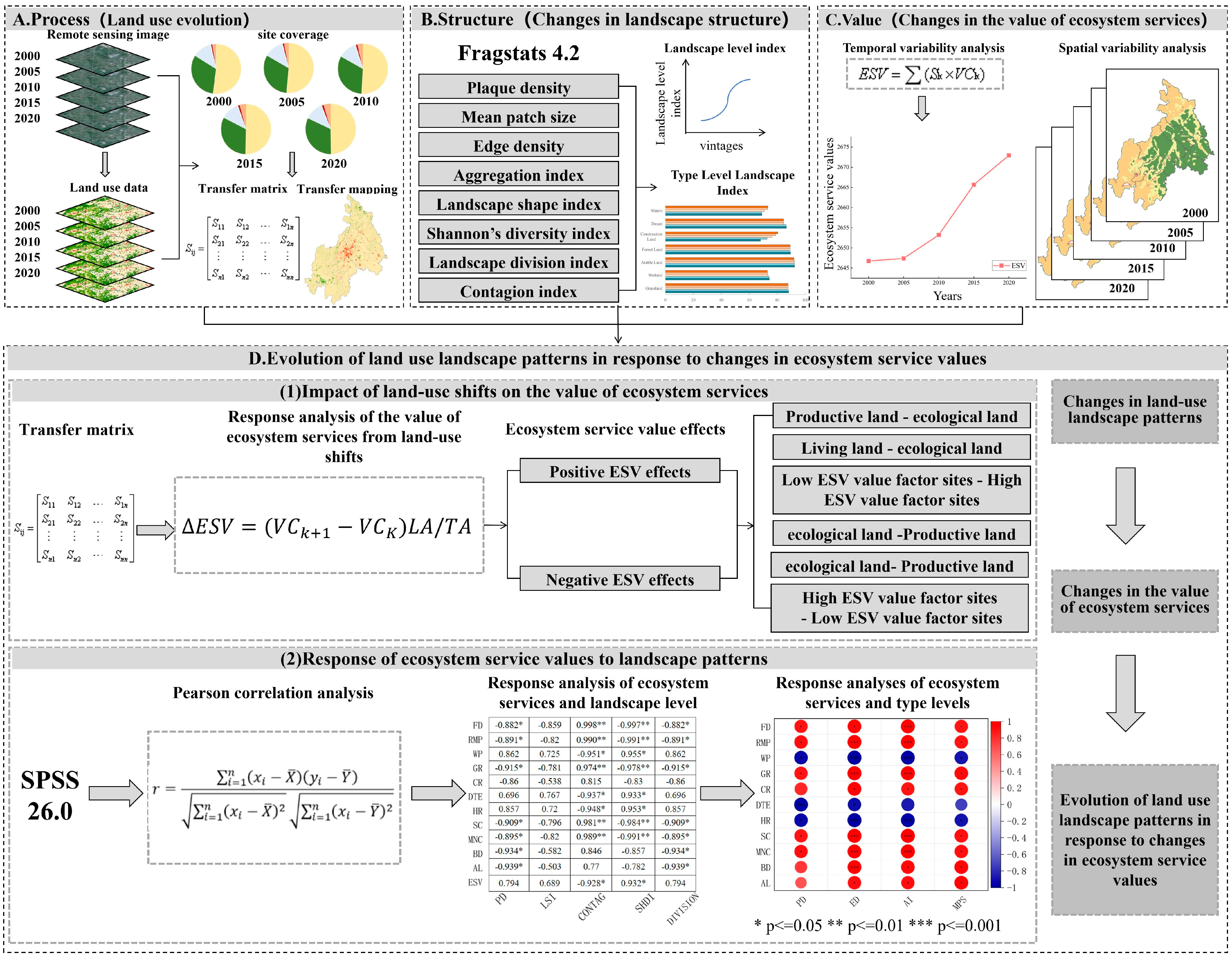
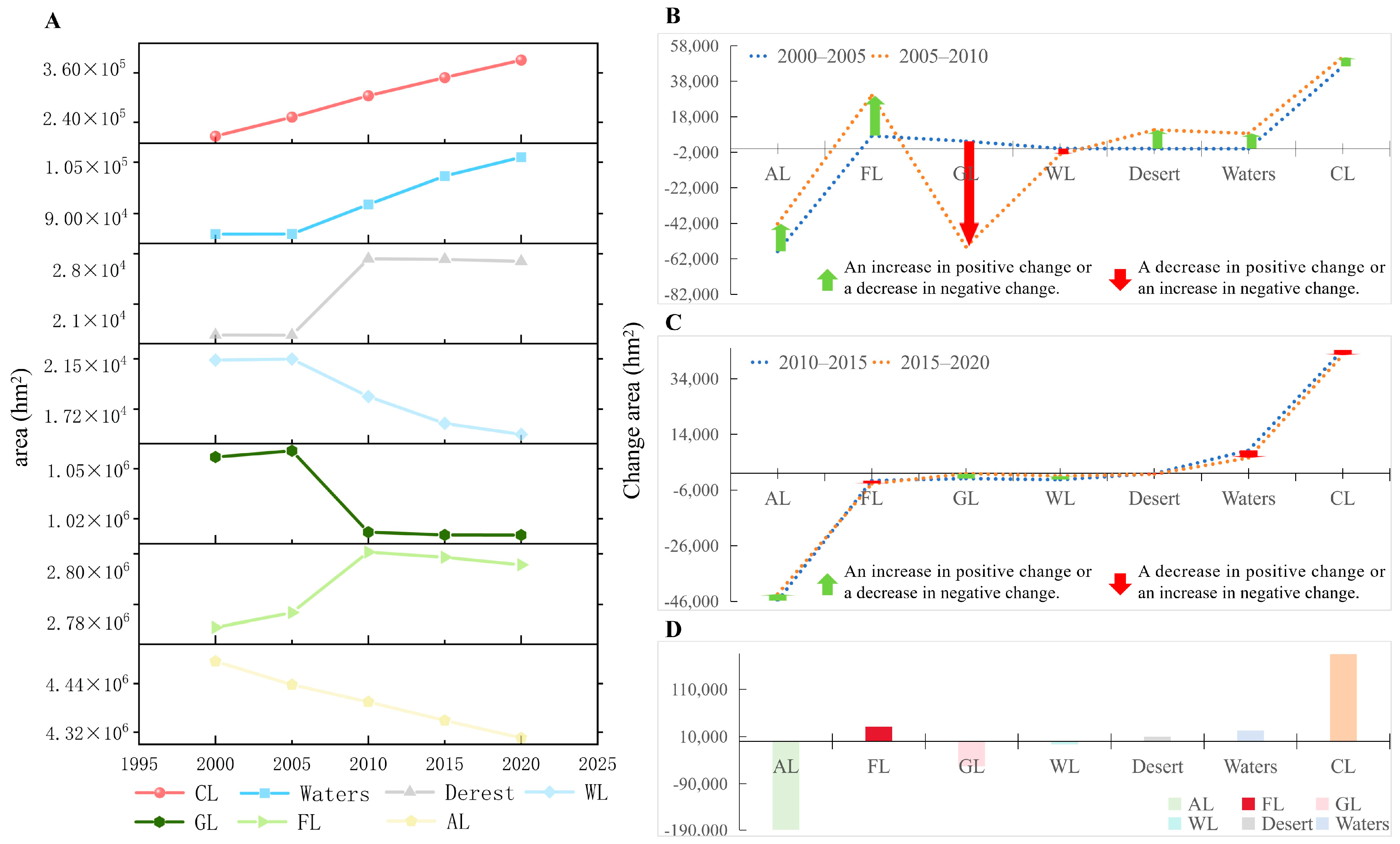
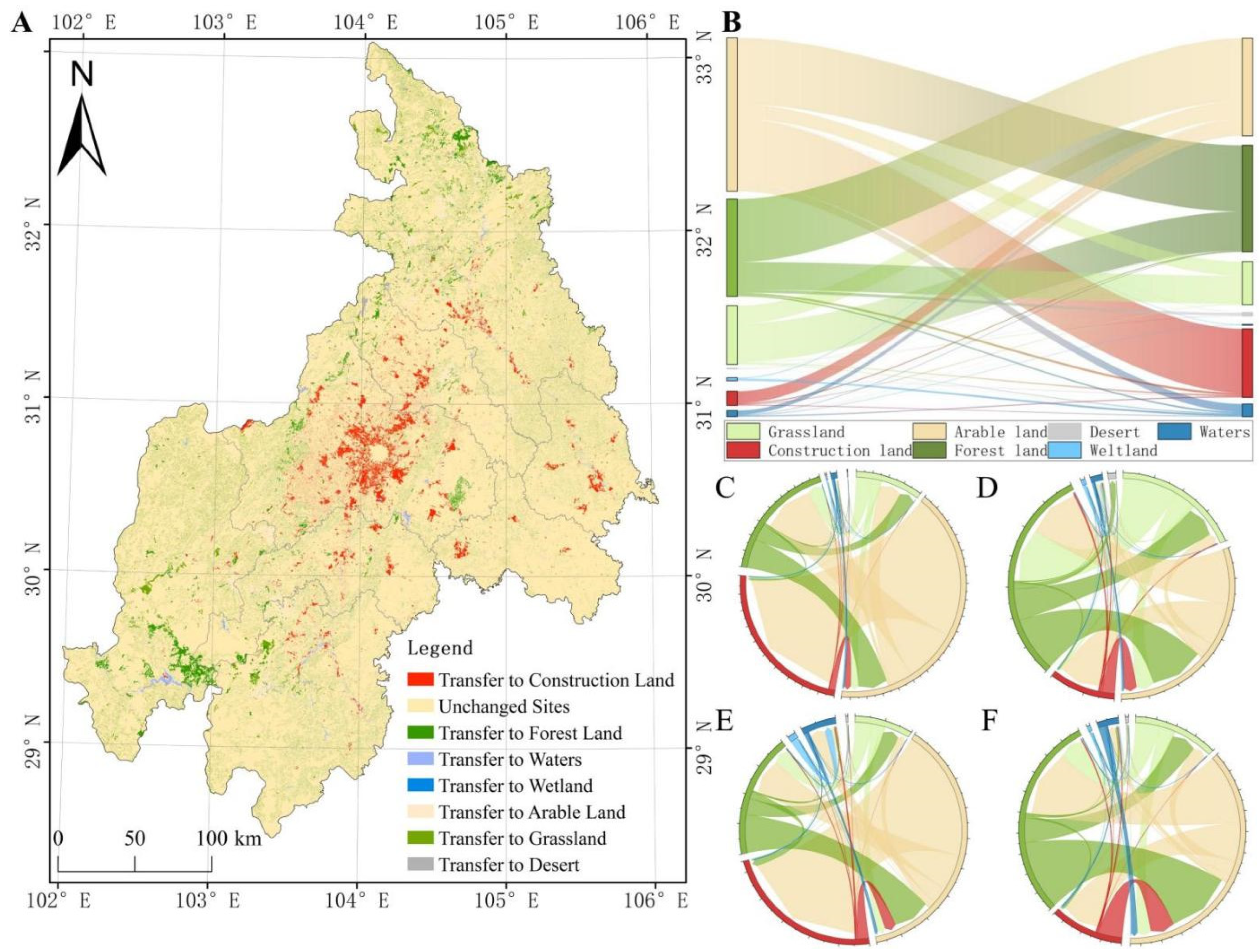
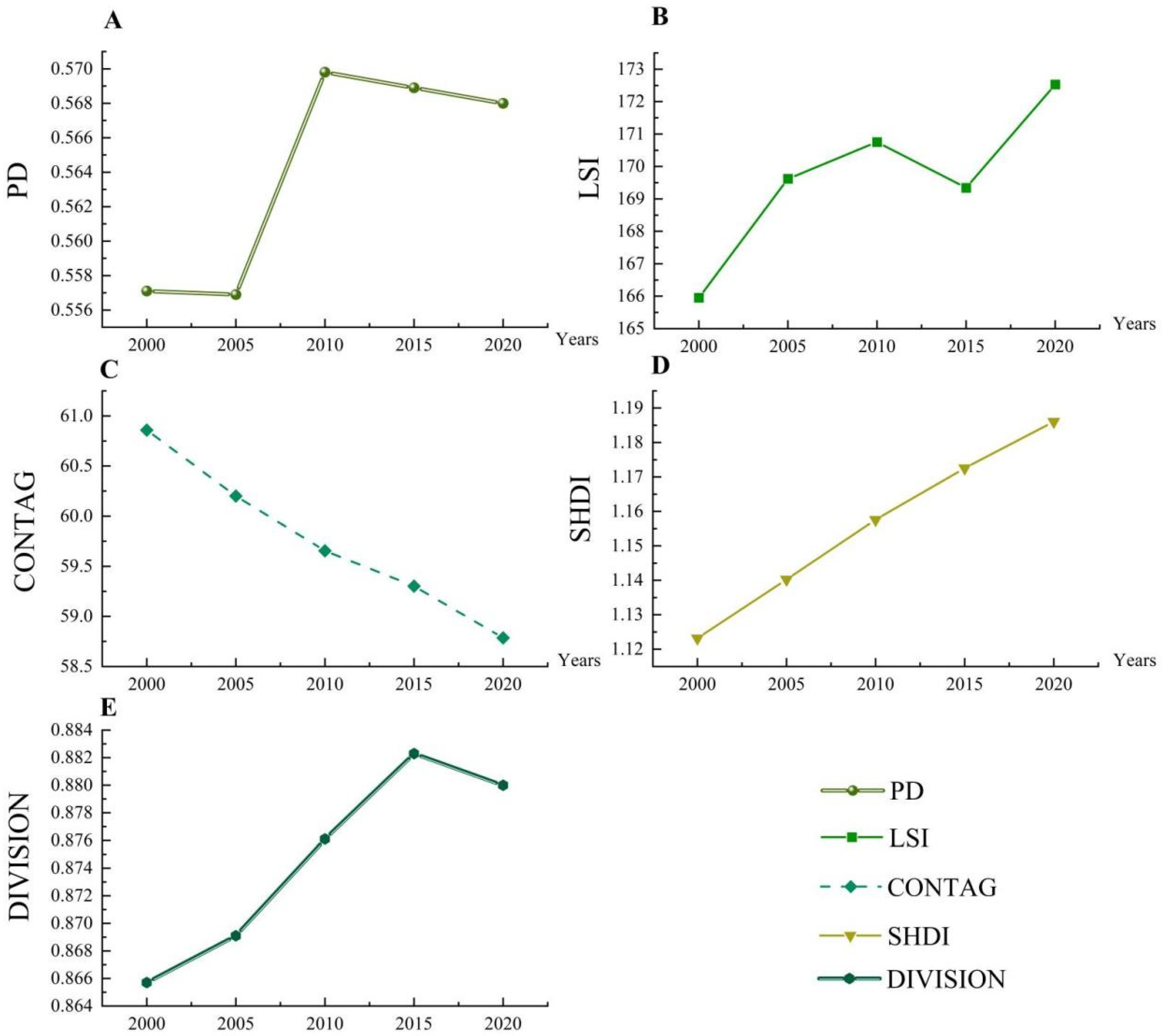
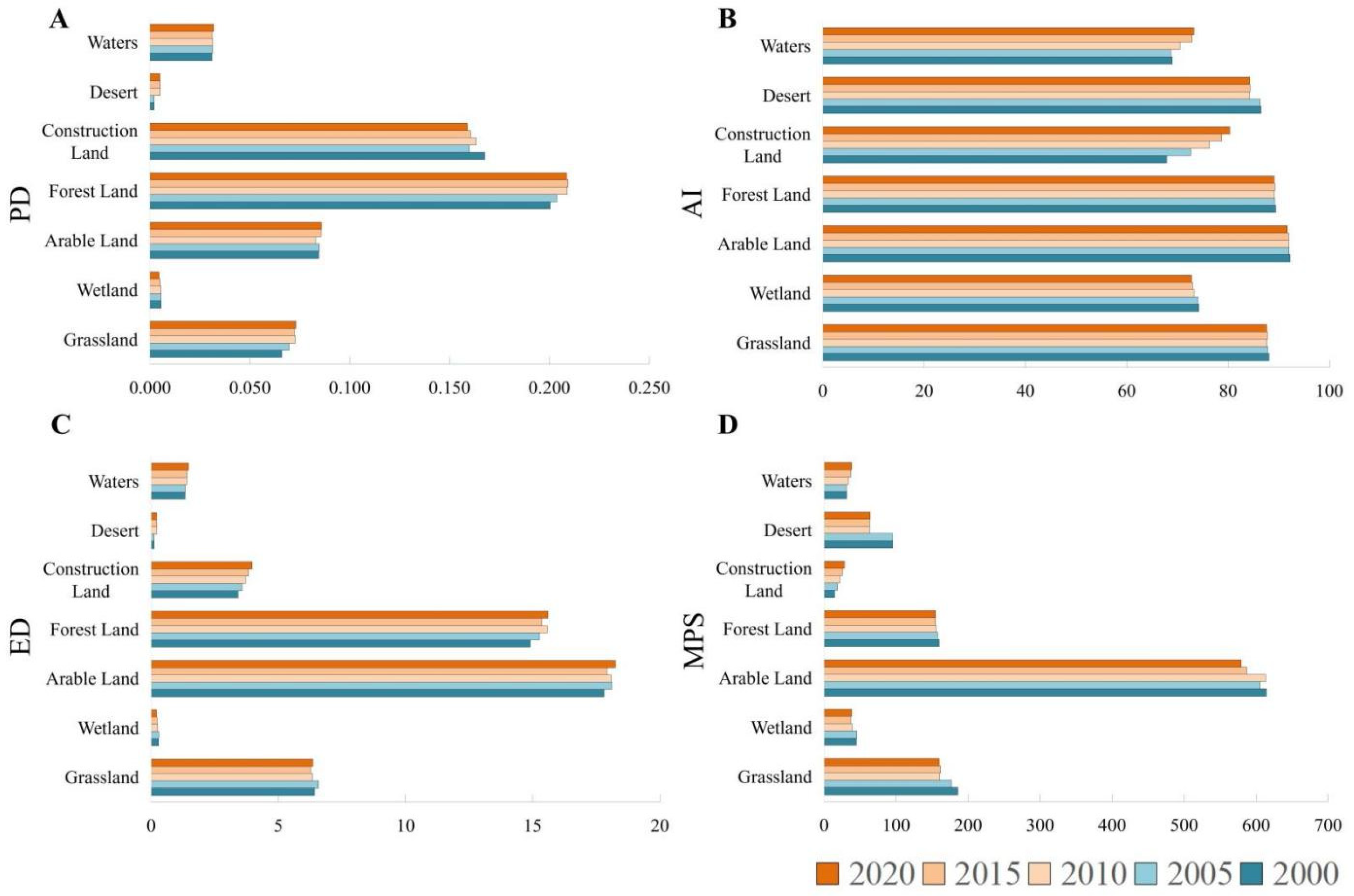

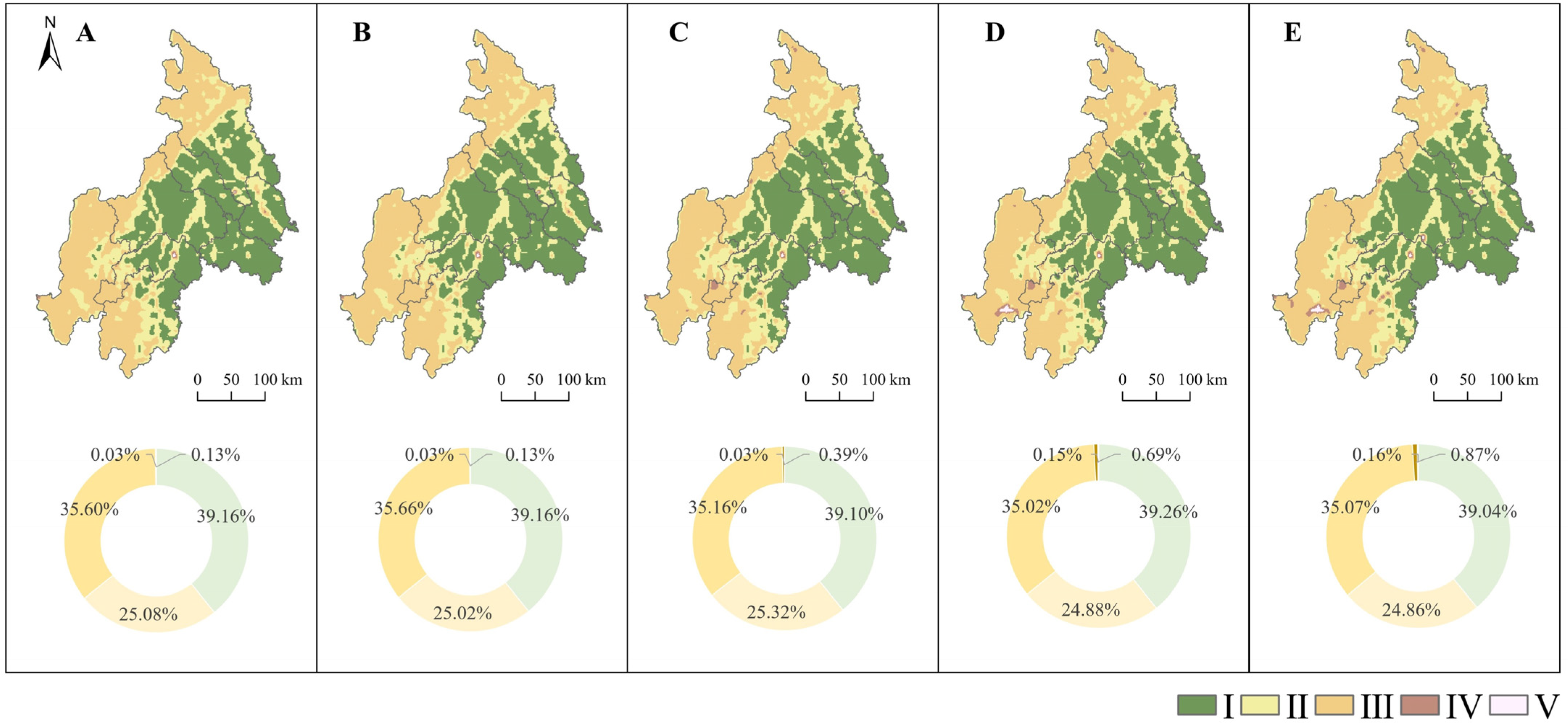
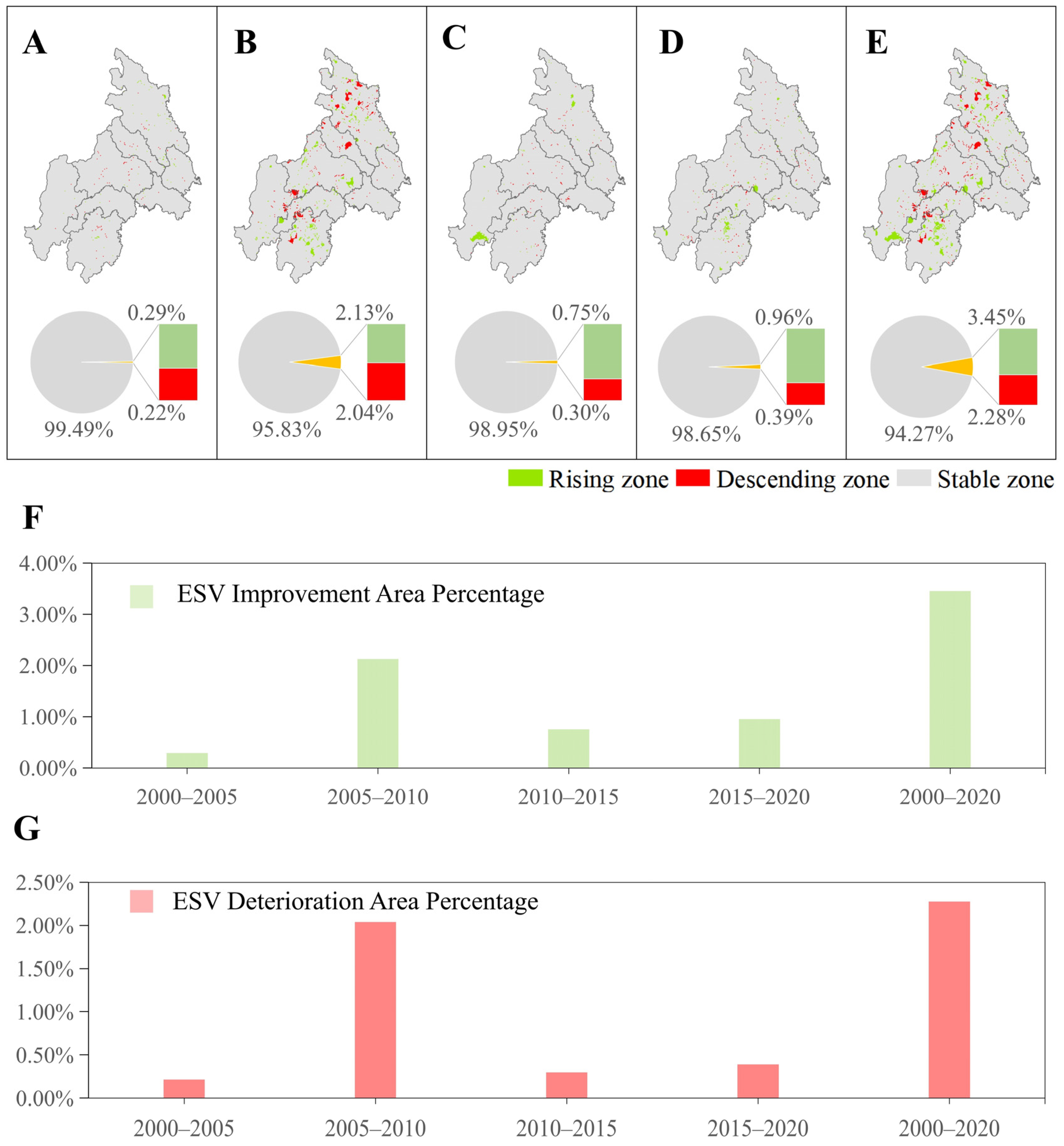

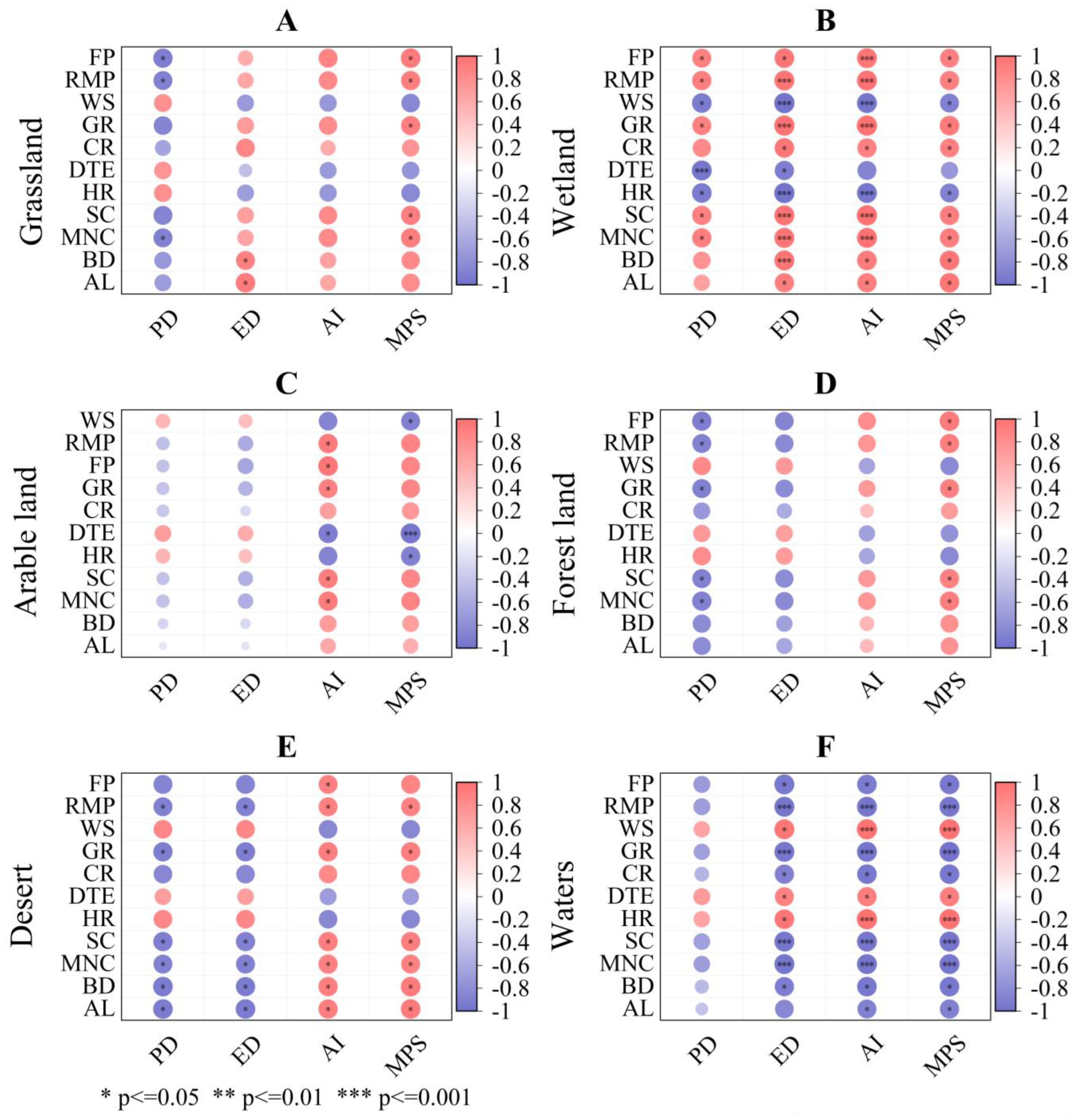
| Land Space | 2000 | 2005 | 2010 | 2015 | 2020 |
|---|---|---|---|---|---|
| Arable land VC ± 50% | 0.15855 | 0.15647 | 0.15464 | 0.15232 | 0.15039 |
| Forest land VC ± 50% | 0.56532 | 0.56665 | 0.57153 | 0.56832 | 0.56602 |
| Grassland VC ± 50% | 0.18383 | 0.18452 | 0.17457 | 0.17343 | 0.17295 |
| Weltland VC ± 50% | 0.00936 | 0.00939 | 0.00798 | 0.00694 | 0.00652 |
| Desert VC ± 50% | 0.00003 | 0.00003 | 0.00005 | 0.00005 | 0.00005 |
| Waters VC ± 50% | 0.08291 | 0.08293 | 0.09123 | 0.09893 | 0.10408 |
| Construction land VC ± 50% | — | — | — | — | — |
Disclaimer/Publisher’s Note: The statements, opinions and data contained in all publications are solely those of the individual author(s) and contributor(s) and not of MDPI and/or the editor(s). MDPI and/or the editor(s) disclaim responsibility for any injury to people or property resulting from any ideas, methods, instructions or products referred to in the content. |
© 2025 by the authors. Licensee MDPI, Basel, Switzerland. This article is an open access article distributed under the terms and conditions of the Creative Commons Attribution (CC BY) license (https://creativecommons.org/licenses/by/4.0/).
Share and Cite
Wang, J.; Peng, P.; Liu, T.; Wang, J.; Zhang, S.; Niu, P. Revealing the Spatiotemporal Changes in Land Use and Landscape Patterns and Their Effects on Ecosystem Services: A Case Study in the Western Sichuan Urban Agglomeration, China. Land 2025, 14, 1012. https://doi.org/10.3390/land14051012
Wang J, Peng P, Liu T, Wang J, Zhang S, Niu P. Revealing the Spatiotemporal Changes in Land Use and Landscape Patterns and Their Effects on Ecosystem Services: A Case Study in the Western Sichuan Urban Agglomeration, China. Land. 2025; 14(5):1012. https://doi.org/10.3390/land14051012
Chicago/Turabian StyleWang, Jing, Peihao Peng, Tao Liu, Juan Wang, Shiqi Zhang, and Pengtao Niu. 2025. "Revealing the Spatiotemporal Changes in Land Use and Landscape Patterns and Their Effects on Ecosystem Services: A Case Study in the Western Sichuan Urban Agglomeration, China" Land 14, no. 5: 1012. https://doi.org/10.3390/land14051012
APA StyleWang, J., Peng, P., Liu, T., Wang, J., Zhang, S., & Niu, P. (2025). Revealing the Spatiotemporal Changes in Land Use and Landscape Patterns and Their Effects on Ecosystem Services: A Case Study in the Western Sichuan Urban Agglomeration, China. Land, 14(5), 1012. https://doi.org/10.3390/land14051012






